COSMIC WONDER Free Press
Elein Fleiss
Saturday March 2nd 2024
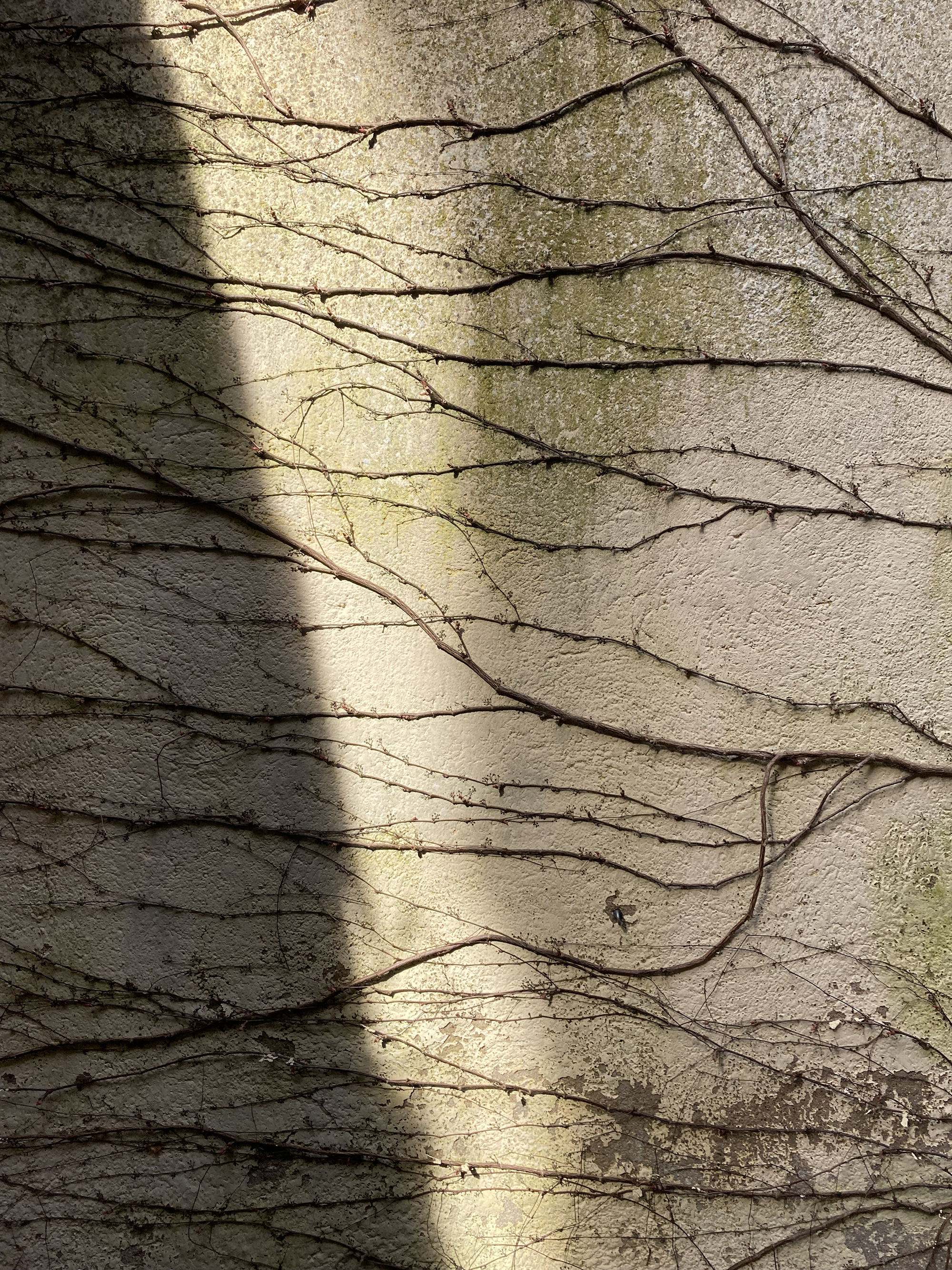
Billions of human beings lived this day in the most diverse ways, happily or tragically, with routine or exceptional events. This is how my day developed.
I woke up a little later than usual, at 9:00. My daughter was at her father’s for the weekend so I was alone in the house with my three cats. The first thing I saw was my cat Mitsu’s face. She was trying to get under the bed quilt but it was time to get out of bed.
I turned my shower on and quickly noticed two things – there was no steam and the bathroom itself was freezing. I soon discovered that the radiator was cold and there was no hot water. The staircase light was not working… not the greatest start. Fortunately I solved the problem quickly, turned the electricity back on and heard different and familiar sounds in the house—fridge, computer, printer, boiler, all starting up again.
Having to wait for the water to heat, I prepared some of the green tea my friend Aya brought me recently, had breakfast— avocado, prosciutto and bread—and after that, a coffee with spices. For the past few years I’ve been adding spices to my coffee (cardamom, cinnamon, nigella, coriander seeds), I grind them every other day so they are strong and fresh.
I went into my very small garden to check if anything new had grown. Spring started a few weeks ago, in February, which is unusually early.
Then I spent time on my phone, searching for vintage clothes, something I do very often, for my shop and for myself. I’ve become passionate, or rather obsessed, always trying to discover some minor forgotten brands. My life is like a permanent treasure hunt these days. I admit it’s addictive but I will probably get tired of it at some point.
I also had a glance at the terrible news of the world, online.
After that I could finally get ready, cleaned. I wore a pair of Cosmic Wonder jeans with a Yohji Yamamoto sweater my mother gave me, and that she customized. Who would dare customize a Yamamoto piece, transforming a cardigan into a sweater? My mother did! But I have to admit the result is interesting.
I went to my store, which is at the corner of my house, to bring in some new clothes. Sunday morning, because it’s market day in my village, is the biggest day in the store, so I needed to have new items.
If I truly listed every little thing I did on this day, this text would be pages and pages long.
At 4:30, I left my home and went to find my car. I rarely remember where it’s parked but this time I found it quickly. I drove to Verfeil, a village 20 minutes from here, where I had an appointment with Flore, a friend of mine and one of the three women I am photographing for my new project which will take place next October in Tokyo. Flore is a beautiful woman, a carpenter and a dancer. A few months ago she gave birth to a second child. When I entered their home, François, her boyfriend, was in the front room and we chatted for a while. I found Flore in the garden. I had brought a white wool coat for her to wear and we left for a walk. She brought a basket and started to pick some wild herbs. The light was grey so I didn’t shoot a lot but it was a good start. In the meantime Flore had filled a basked with wild greens. We went back to her home, had tea and some strange gluten-free chocolate cake. It tasted good.
I drove back to my village, went home to pick a bottle of wine. I arrived a little late at my friend Caroline’s for dinner. Capucine and David were there, the three of them were having beers. Caroline is an architect, her flat is on the top floor of a medieval house that she entirely restored and where she created several flats. On the ground floor, there’s also a good secondhand bookstore. Capucine and David are political activists, so we talked about politics mostly. But they’re funny too, we laughed a lot. Caroline made a vegetable curry, very tasty. We also talked about Studio Mumbai’s exhibition that I had just seen in Paris, following Caroline’s advice. A beautiful exhibition of Caroline’s favorite architect that she couldn’t attend, so I told her what I saw.
Before going to sleep I read some pages from An American childhood by Annie Dillard. I recently discovered this American genius and have been reading several of her books with passion.
Saturday March 2nd 2024 is past.
Elein Fleiss
March, 2024
*Le Batèl, a store that sells vintage clothing, antique objects, tableware, books, etc. that Elein opened with her friend, artist Andy Wilkinson.
Photography by Elein Fleiss
Hanayo
Spring is almost here
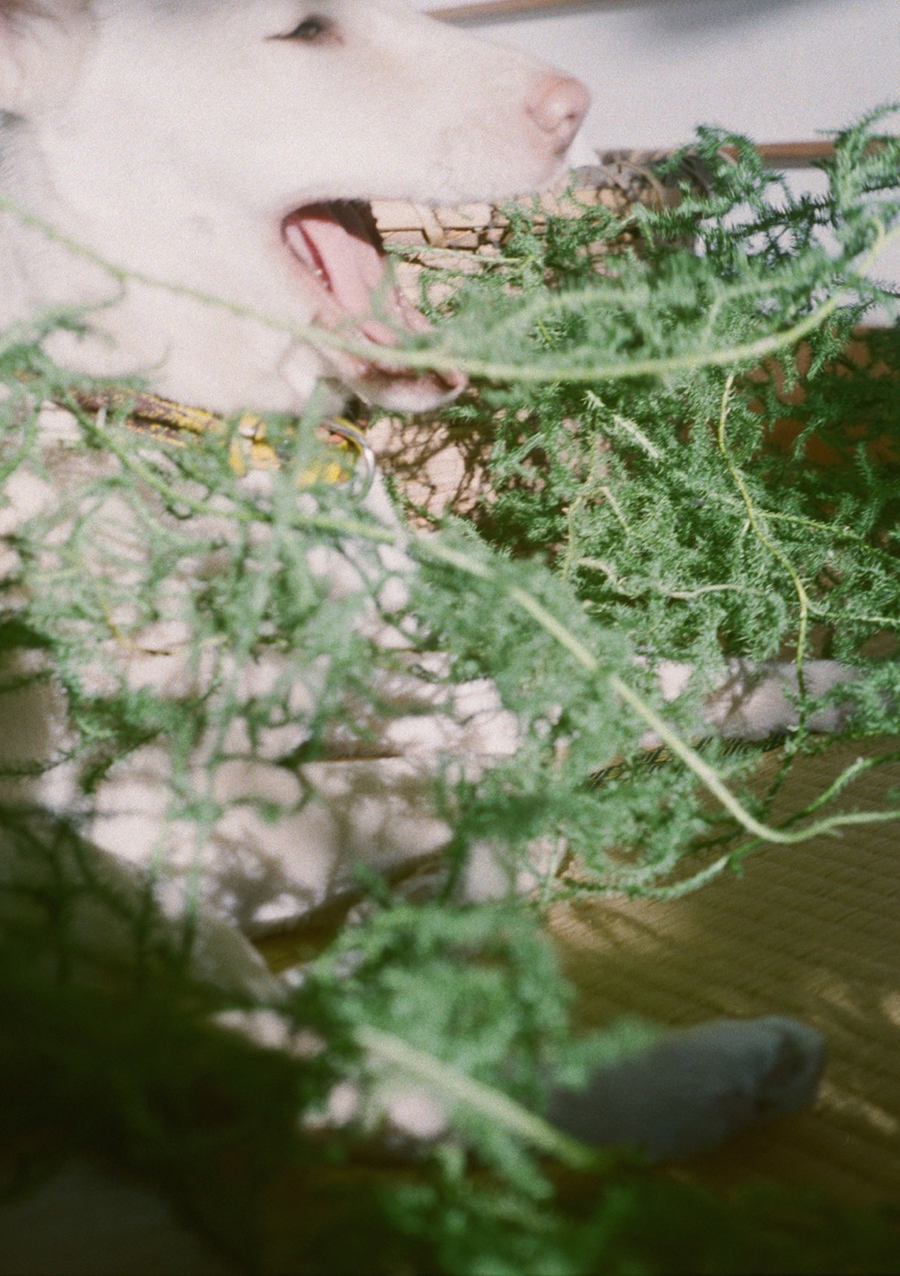
Awataro’s* garden has a fence.
I heard that the animals come down to his garden.
I was very concerned that the wire fence was out of proportion to the thatched roof of the house.
When Awataro visited my garden in Nogata, he admired my wild roses, japanese honeysuckle and wisteria ivy.
We talked about twisting those ivies around the fence of his garden one day.
An elongated, bright jade-colored moss-like plant arrived at New Year’s from Awataro.
He told me to decorate the tokonoma with it.
Every New Year’s Day in Edo is surprisingly cloudless and sunny.
The moss is glistening in the tokonoma on the second floor of our house.
Its leaves are dry and the first day of spring has passed, but they shine just the same.
I decided to send the promised set of plant seeds as a thank-you.
In addition to the ivy, I have seeds of kibana cosmos, hagi tree, fujibakama plants, akigiri leaves, and japanese morning glory that will look good in the garden throughout the year.
I also included some sheet music of Hauta, a traditional Japanese folk song that I am currently practicing.
When I met him later, he was very pleased with the parcel.
However, I’ve heard that keeping a garden in the mountains is not a simple task.
It is a constant struggle against the weeds.
If the weeds are not cut with an electric mower at least once a month, they quickly take over.
When that happens, mamushi pit vipers may enter the house, which can be quite dangerous.
Perhaps my dream of living in the satoyama is a foolish one.
*AAWAA
Hanayo
February, 2024
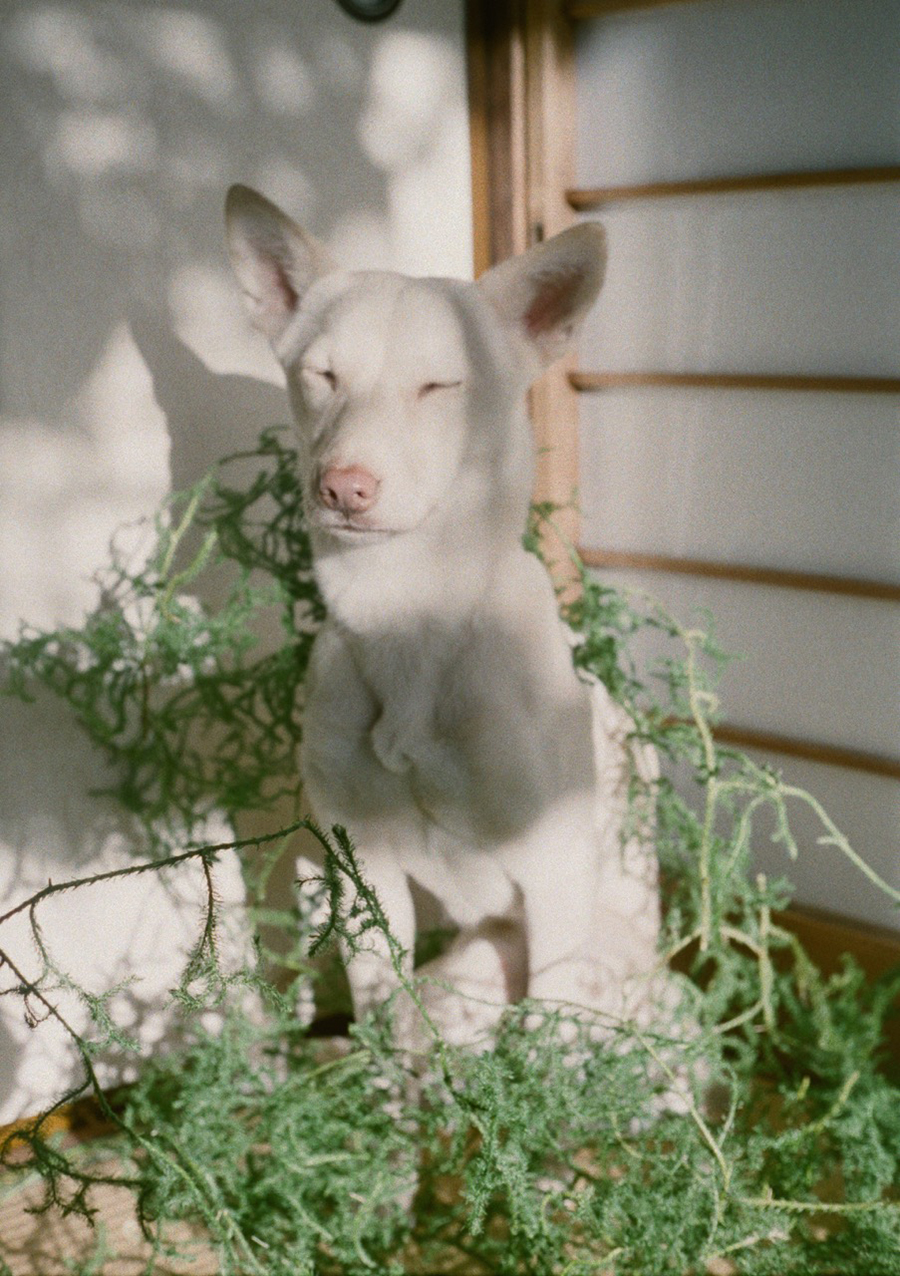
Photography: Hanayo
Masaho Anotani
LINALSASI
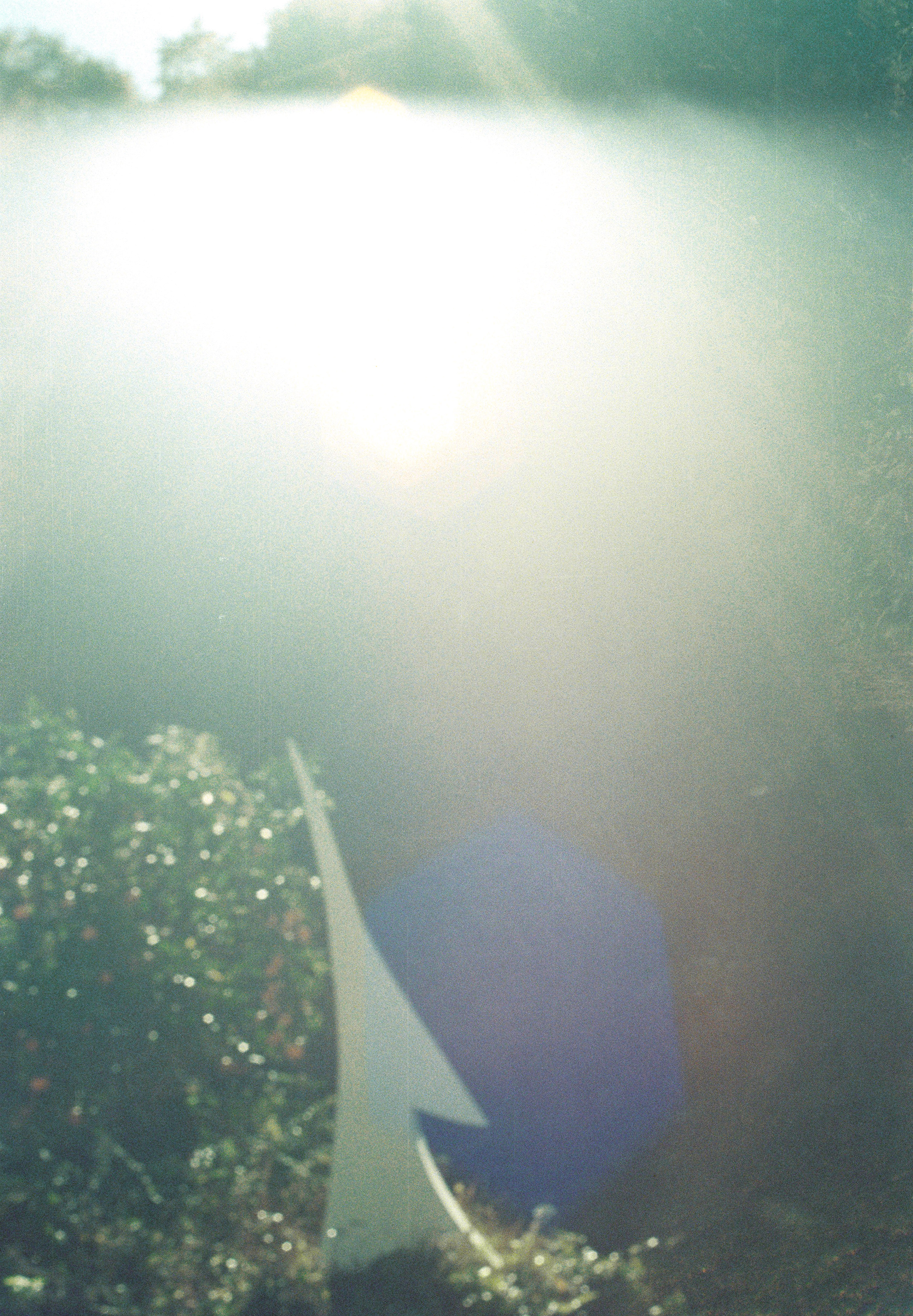
LINALSASI
you shine your way LIGHT
LINALSASI
you beyond your way RIGHT
my hope (la la la) like a dreaming stream going on the rye
my home (lu lu lu) like my soul to live to believe
Daydreaming Man Stoned like an unknown stone
Got caught in the rain BRAIN
Stray man who is going rolling
like a curl of smoke
Now worm-up
How wake-up
HALF AWAKE highway day driver stepping on a loose pedal aimlessly
OVERDONE no way day massacre act of mercy goes too far OVER
FUZZY LAZY all day just a reminder Let’s over to slave away
flowing over lonely overloader now ZERO downloader
I wanna be free from the past let it go
DIFFERENCE be the ONENESS
YOU are UNLIMITED
CHOICE eternal internal VOICE
IMAGINE WING – BEING WIND
CENTERING SOUL – GATHERING CALL
LINALSASI
It’s a magic all in you
LINALSASI
Now imagine to enter your gate
To give my heart to the wind Just going in front
I go before it shake me off CONCENTRATION in harmony
AMBIENT WIND – BLIND CONVERSATION
VIOLET SUNSET IN THE AIR
soft and clear body like a spring cabbage NOW I feel
Dive into YOU in between VAGUE and VAGUE for sure
LOVE MYSELF
ON A MAGIC PASSAGE
MEETING MY SOUL GOLD
VISION RESOLUTION GOOD
HIGHER REVOLUTION GO
Masaho Anotani
Video letter from Miranda July
Ni
AAWAA
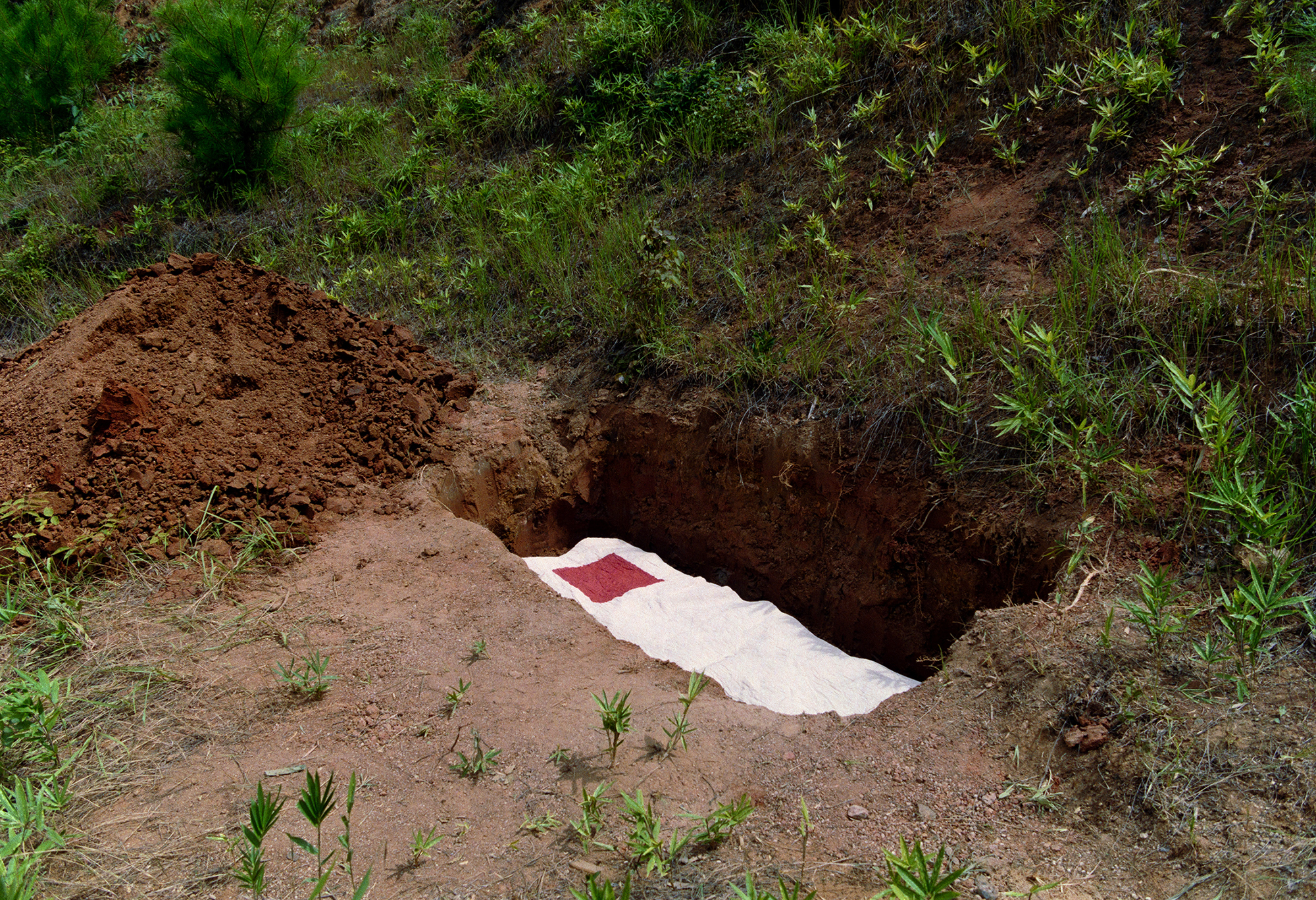
I have begun a study of clothing in Tamba. When I say clothing, I am thinking of the nightgowns and bedclothes that were made long ago in the ancient Tamba province.
In the past, the ancient Tamba Province was a large kingdom that stretched from the Tango Peninsula to Miyama in Nantan, which is where I live, and to Hikami and Taki in Hyogo Prefecture. The Tango Peninsula was the center of the kingdom and many ancient burial mounds and ruins can still be found there. Many Jomon-era ruins have also been discovered, giving one a sense of the life of the Jomon people. It is said that the name “Ni” comes from the brownish-red soil of Tamba and Tango because of its high iron content. Living in the area, one can see patches of red soil and reddish stones in mountain streams. Some of the well water also has a reddish tinge.
Red has been considered a precious color since primordial times. In the Jomon period, people painted their faces and bodies with bright red cinnabar. Cinnabar is a mercury-based mineral, and the finer it is crushed, the more vividly the vermilion red color appears. Jomon period earthenware with cinnabar has been excavated from the Kannonji-Honma and Sara-Okayama ruins in Kashihara City, Kashihara Prefecture. In the Yayoi period, cinnabar was used for the burial of rulers. Many pieces of earthenware decorated with cinnabar have been excavated from tombs. In the tombs of the Tango Misaka Shrine, soil stained bright red with cinnabar was also excavated, and a piece cut out of the soil is now in the archives of the Tango Museum as a research artifact. It is a beautiful red and the intense contrast of earth and vermilion gives the impression of the ancient colors as they were.
Silk was introduced to Tamba in ancient times and its use continues through the present day. Tango Chirimen, a traditional silk cloth, is still produced according to the ancient technique that has been handed down to the present. In the distant past, when people were laid to rest in wooden coffins dyed red with cinnabar, were they dressed in silk? Cinnabar was applied to their faces, bodies, and clothes. They were buried in red, praying for the resurrection of life. Now we see only the red vermilion in the soil of the Ni.
AAWAA
August, 2023
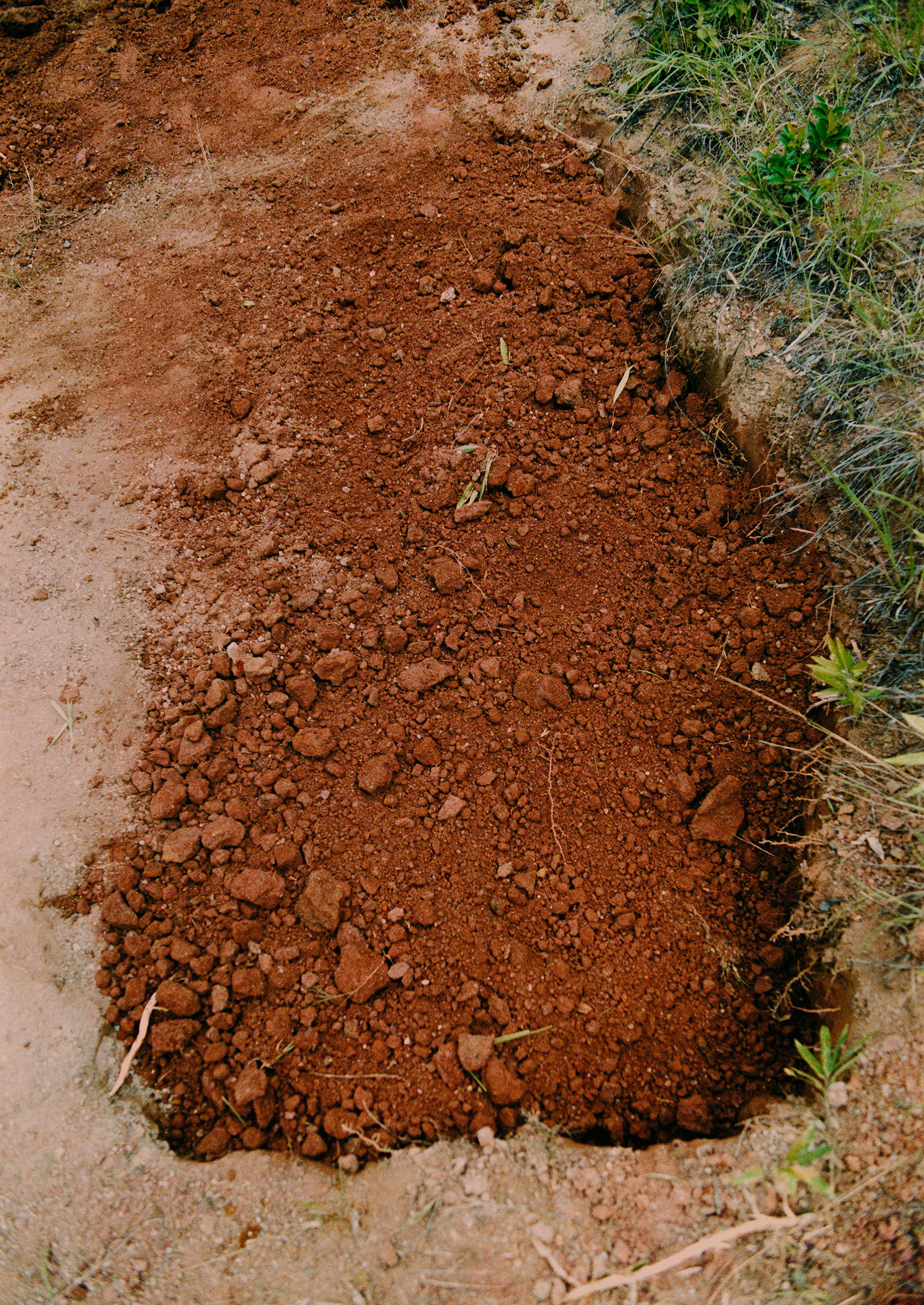
Le Batèl
Elein Fleiss
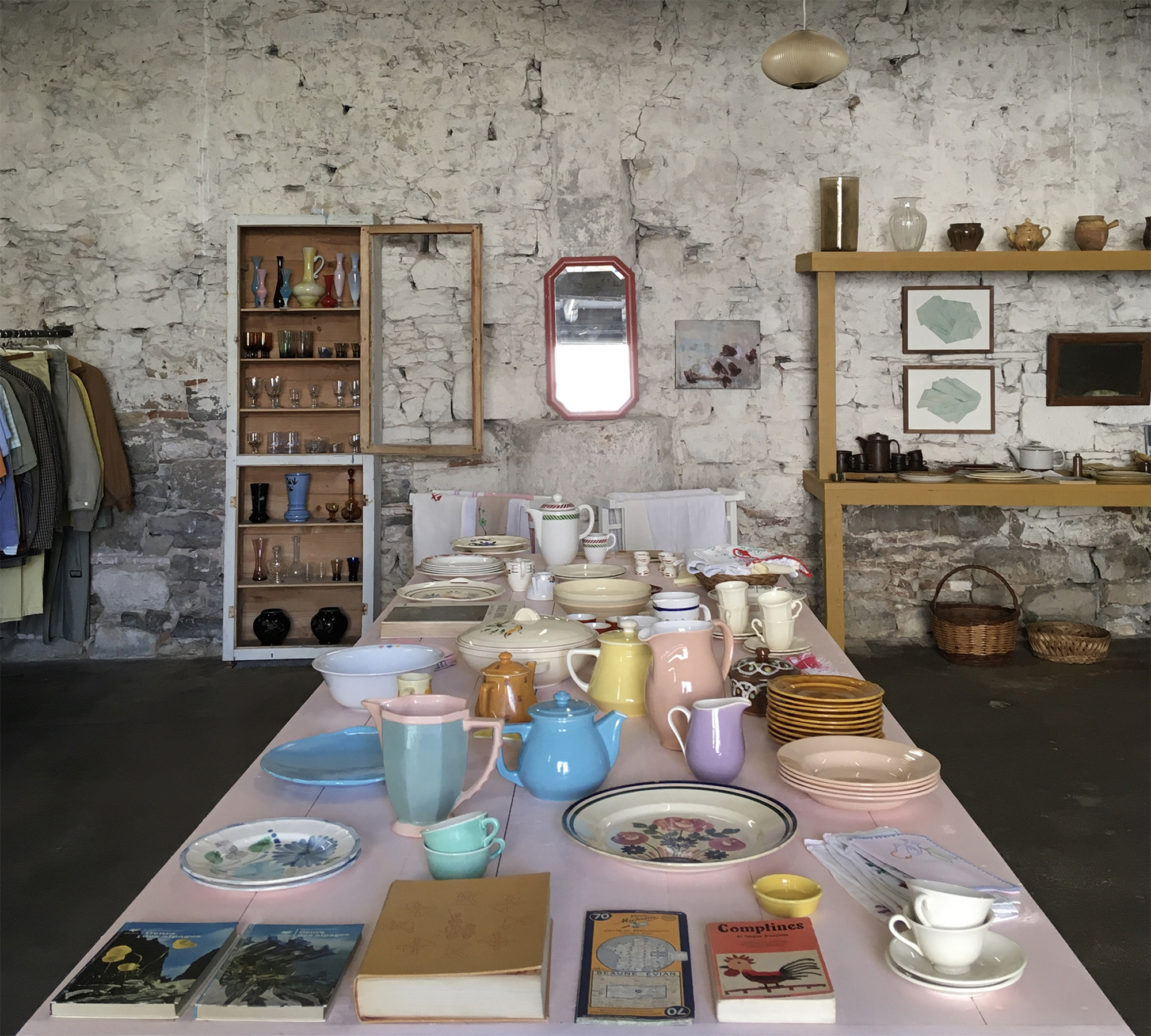
Last July, with my friend the English artist Andie Wilkinson, I opened a store in my village (Saint-Antonin-Noble-Val in South West France) where we sell vintage clothes and antique objects, dishes, books. Together we designed the layout to display objects and clothes mixed with our own artworks as though we were creating an art installation.
This new project is not so much about selling but mostly about buying. Andie and I work independently sharing the same spirit. I buy what I find beautiful, anything that attracts my eyes. Hand blown glasses, an old metal and wood tool, a cup, a skirt, gloves, a bag, a leather purse, wool sweaters, a pile of plates, a men’s coat, a vase… I become passionate searching. Finding something beautiful is very difficult. I go to thrift stores, charity stores, anyplace where people give away whatever they don’t want. The stores are often in suburban areas or industrial zones of small towns. Most of the merchandise is ugly and of poor quality, all unsorted and there is a tone of it. I look through racks and racks of clothes, endless stacks of clothes on trays, piles of plates, shelves filled with cups, glasses, books, baskets of scarves or jewelry… I never know what I will find, if I find anything but then I find a treasure. An incredible ceramic piece for example. When my eyes see something beautiful, I am filled with emotion but it can create a dilemna : Should I keep it for myself ? « No, you have too many coats, this one is for the store ! » or « No, you don’t have any space on your cup (or teapot) shelf anymore ! » But when the desire is too strong, I keep the new item and will eventually sell another one from my personal collection.
Doing this work since six months, I’ve learned a lot about European ceramics, the different brands that existed during XXth century. My taste evolved over time, I get tired of some colors or patterns and suddenly am attracted to a new one. It’s a mystery. I try to follow my senses as much as possible and not to think about it. Thinking could lead me to the wrong direction, for example buying something that I think would sell easily and that I don’t particularly like. I don’t want to do that. I prefer to buy something I love and that I doubt I will ever sell. But I’ve had surprises and found out there’s always someone that can share my taste. I discovered that commerce, when you do it with your heart and sensibility, is about sharing, just like publishing.
*Le Batèl means the boat in occitan (France), the original language from the region where I live.
Elein Fleiss
March 2, 2023
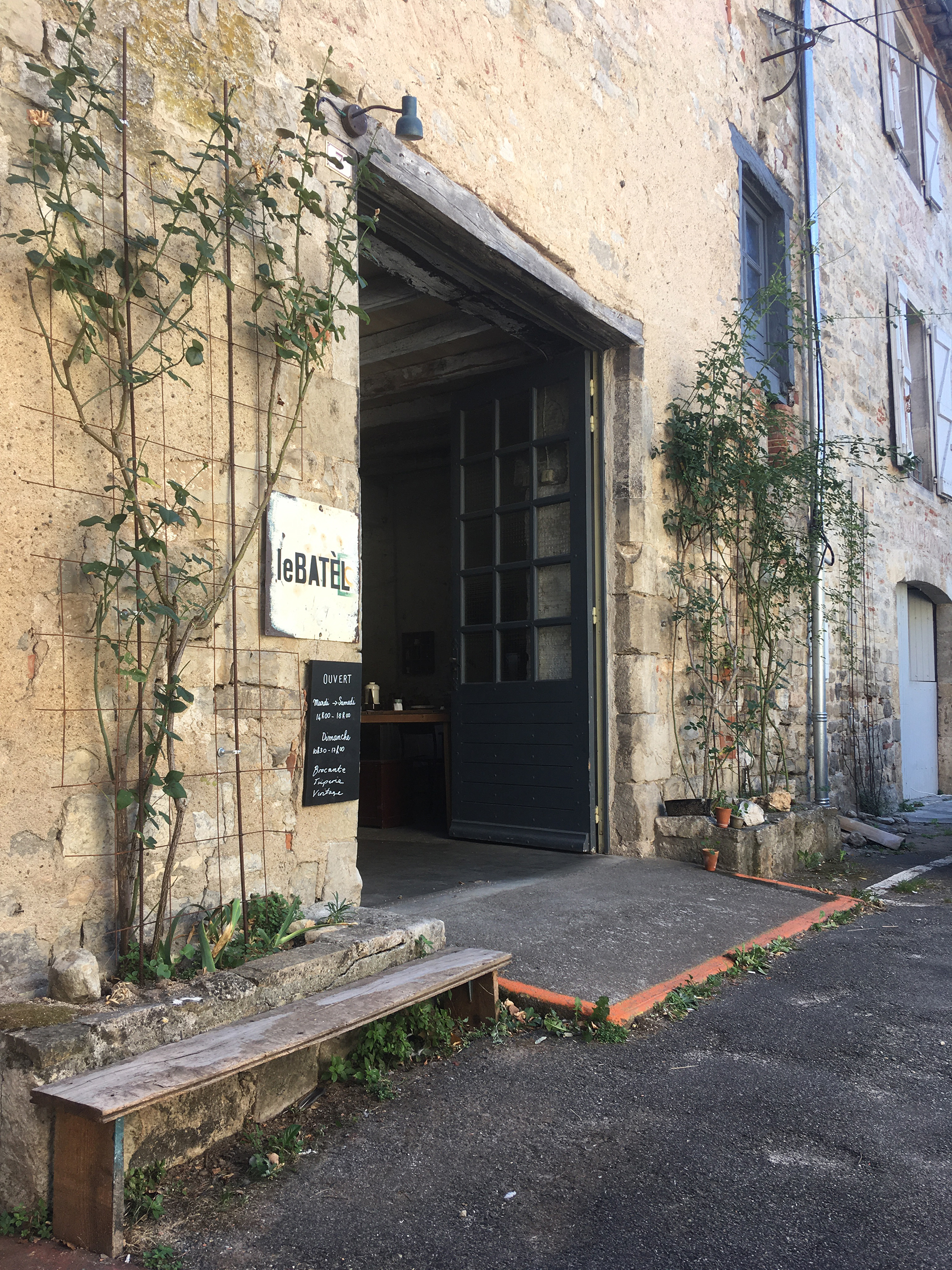
Meeting room at North Village
AAWAA

My village has an interesting meeting place. It is a large house, about 300 years old, with a thatched roof, an earthen floor, a well-used kitchen made of wood and clay, and tables that can accommodate many people. It is more like an open kitchen for the village than a meeting place. It can be used by anyone living in the village at any time and the kitchen is open for people to bring a variety of ingredients, cook delicious food, and eat freely. It is a place to talk and to share extra food or to find some if there is none at home. If someone cooks a meal and there is not enough for the next person, someone else who can cook will cook. Those who don’t want to cook don’t have to and those who don’t want to talk can eat in peace, making it a place where each person’s comfort is respected. This is based on the principle that everyone should enjoy what is left over from the fields and farms. The food is sometimes paid for by the village budget and sometimes not. The kitchen gathers an abundance of high-quality rice, vegetables, eggs, and meat, some of which comes from the village farms that use natural and pesticide-free methods, or else from local gardens and fields. Processed goods are also made at a factory in the village and leftovers are left at the meeting place. Mutual respect among the villagers is the reason for the longevity of this place.
We also go to the meeting place when there are new ideas to propose or when we have some problems. We discuss things with the people there before raising the issues at the big village meeting. Of course, the big village meeting is also held around this table. There was one item that once came up on the agenda and developed into an interesting project. It was a question of what to do with the mountains and forests owned by the village, which had borne so many years of human intervention. After consulting with engineers, researchers, and others in various fields, we are gradually returning the mountains and forests to their natural state. This is also about restoring our own intuition and our sense of self that is reflected in our environment.
There is a day I look forward to. It is when we have a cook from the village, or perhaps from outside the village, who comes and cooks a special meal with our local foods and many people in the village gather together. At this time we might pay for the food, or else give the cooks gifts in exchange. We are all dressed up for this gathering. My current source of inspiration is the clothing of the villagers who gather here today. Just the other day, there was a sort of international cooking party. All were dressed up in such style, though I was especially impressed by the men who were dressed in work clothes that could have been more than 100 years old. An elderly woman with long gray hair who lived in the village also captured my attention. She came wearing a long European 19th century black dress remade to be worn loosely, with a small deerskin bag in her hand and Korean shoes with pointy, warped toes. Her hair was likewise styled in a fluffy 19th century knot. She radiated a sense of freedom, transcending time and place, a relaxed humor, and above all, a kindness ready to embrace everything with a rich unbounded heart.
AAWAA

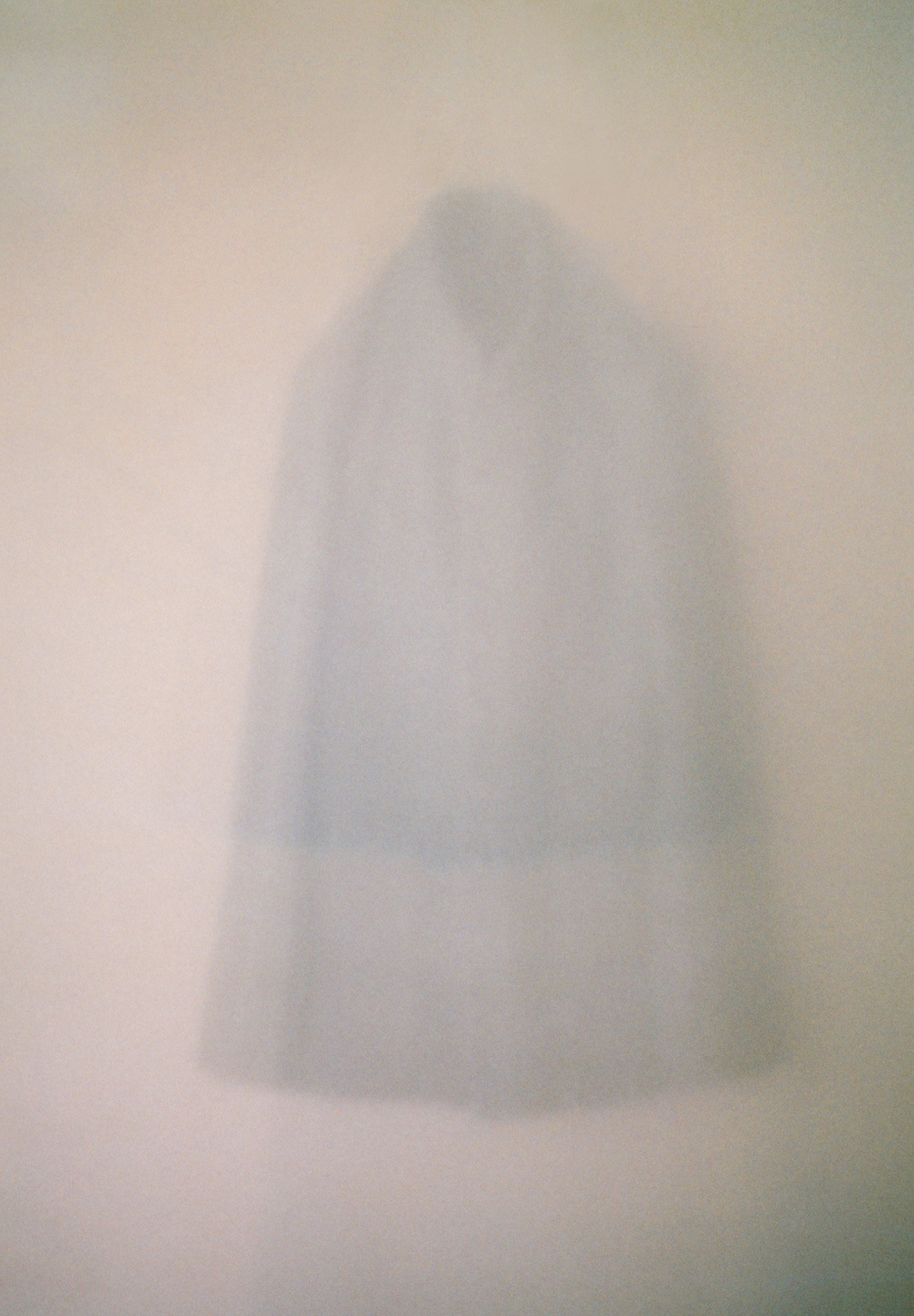
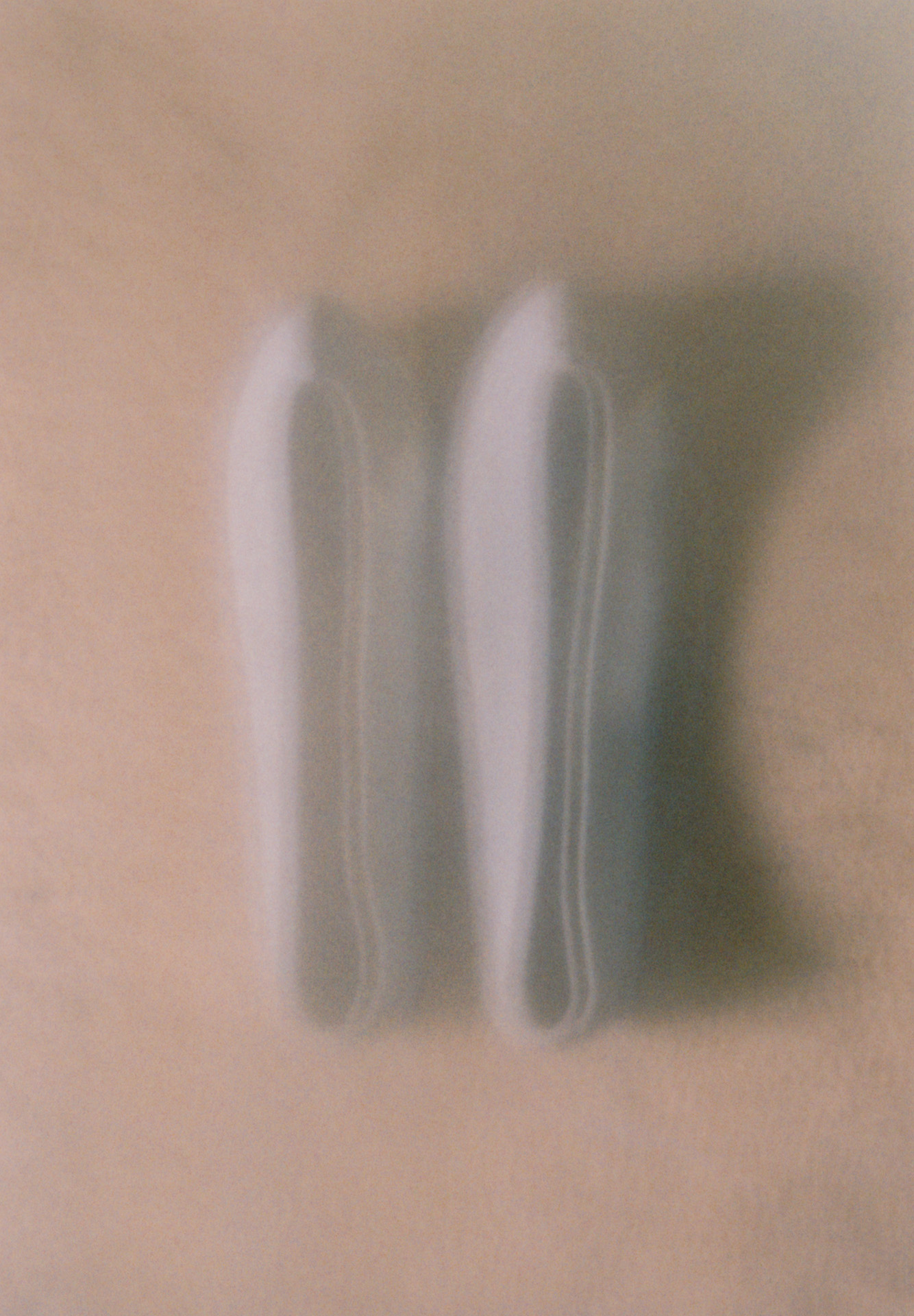
From the top in the photo
Sun-dried bricks for meeting room
19th century’s hemp bag
Organic cotton tweed workwear made with a garabou*
*A spinning machine that mimics hand-spinning techniques, developed in the late 19th century by former monk and inventor Gaun Tatsumune.
Traditional Korean footwear “Koshin”
Is it Fall ?
Elein Fleiss
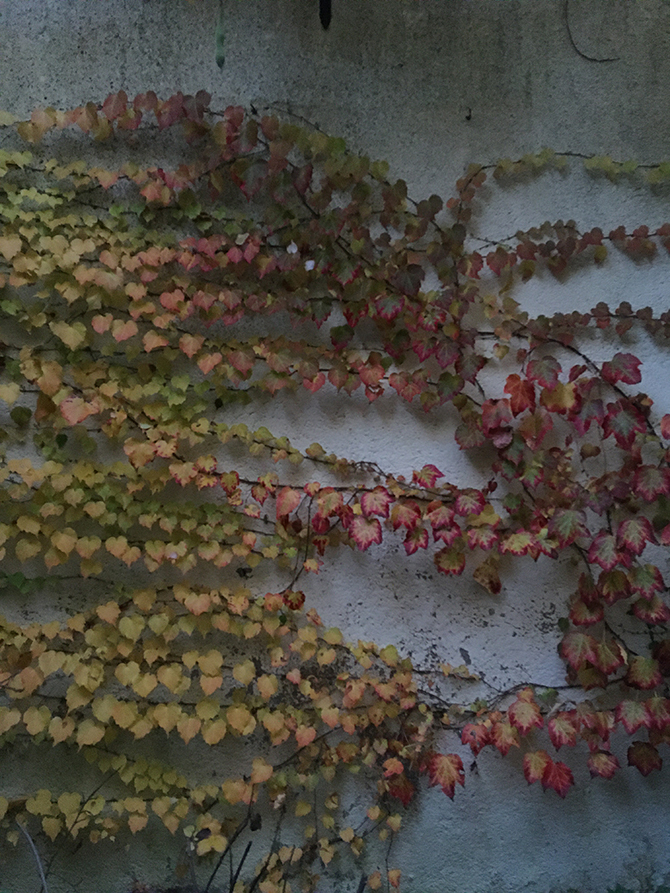
Beige and brown trees — last Summer trees became brown, some died of thirst, green slowly disappeared from the landscape. Summer looked like Fall. Sometimes clouds appeared in the sky, it became darker and darker, we thought it would finally rain, and it did, a few drops, during five minutes. Water in the rivers was low or they were completely dry. But now it is Fall, walnut trees are bright yellow and one morning the fog came back, erasing the landscape. It was on September 27th, precisely, I was driving to a city nearby and that’s when I saw the return of fog. I live at the cross of two valleys, sometimes the fog is above us, like a white blanket in the sky, the hills disappeared and the village is left alone in the whiteness.
Another sign of Fall is the presence of horse-chestnuts in the streets. Two days ago I picked some. A friend had just told me moths do not like the smell of horse-chestnuts. Moths are small butterflies which eat wool. Just after I found out, I took my bike and went to pick some, just in time as they had all fallen from the trees and were becoming dry. I didn’t find as many as I would have liked. I have a special love for wool, and a special love for clothes, so my house contains lots of wool clothes ! Next year I plan to pick hundreds of horse-chestnuts.
I also noticed beautiful collars of red five-leaved ivy hanging on stone walls, in my garden the wisteria is turning yellow, and pink Japanese anemones are blooming. But still, it is not raining, yesterday it was 27 degrees and roses are still blooming.
Elein Fleiss
October 20th, 2022
Photography: Elein Fleiss
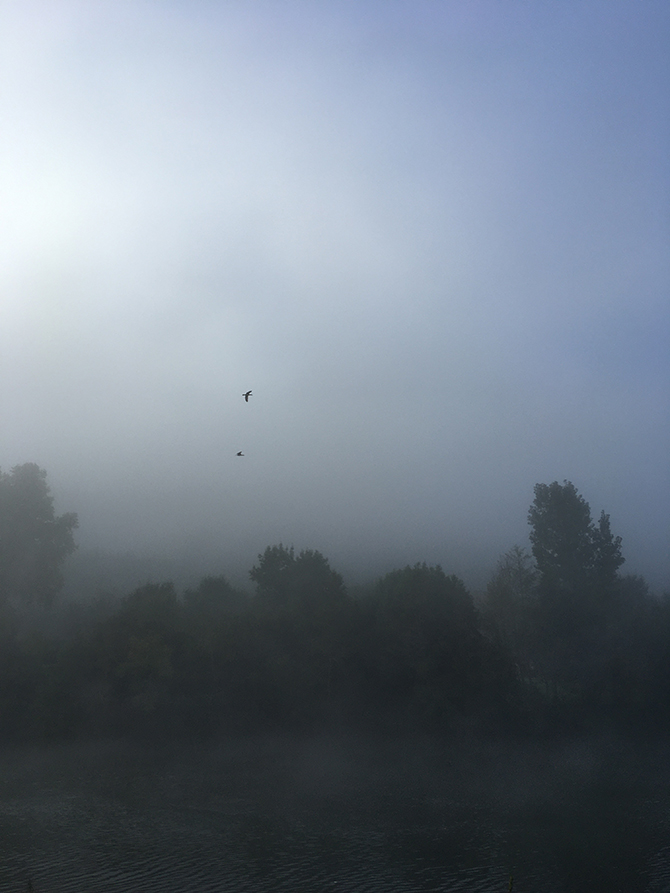
Spring has come Elein Fleiss
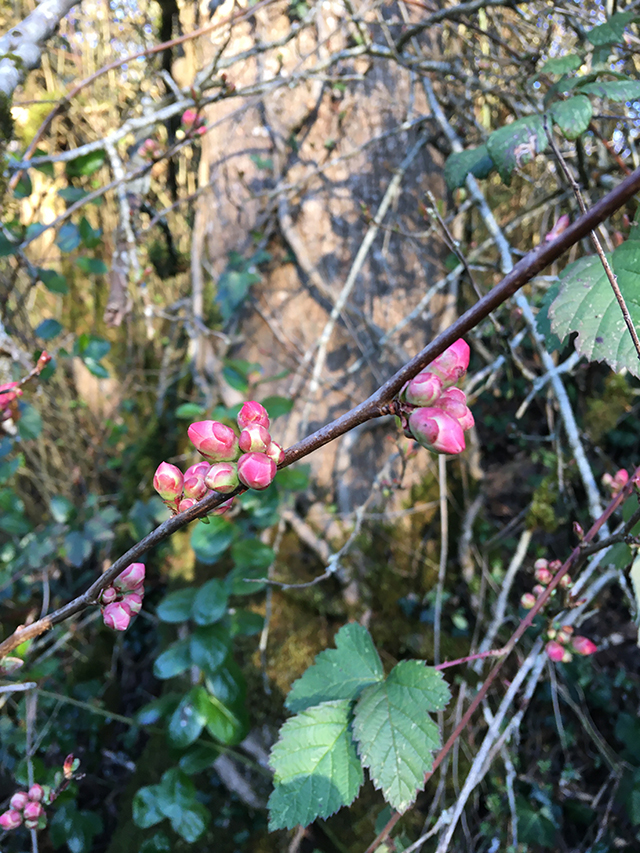
The arrival of Spring is sudden, a new color appears in the landscape, like a little light in the dark. It’s usually on the ground, a flower—yellow or purple. Where I live, the first flower is either a violet, a lesser celandine (ficaria verna) or a dandelion. These appear when the landscape is still in winter.
Another precursor is hazel catkins, these golden bud-like flowers hanging on hazel trees. Any of these signs brings joy. Spring is coming! It might still be cold, freezing at night, but it’s undeniable, it’s happening.
A few days later, I start noticing buds on the shrubs of my little garden and, driving on small roads, white flower buds on cherry trees or very small yellow flowers on male cornel, the first tree to bloom.
After a dormant period, the metamorphosis of nature starts again, and like a ballet, one after the other, tender green leaves will grow on trees, new flowers and herbs will come out of the ground.
Last week I went to the “daffodils wood,” where hundreds of daffodils grow. I can pick a large bunch without any visible effect on the landscape. I was a little too early this year, and could only find a dozen that were blooming. I also started to pick wild herbs that I eat as salads, valerianella locusta, perennial lettuce, dandelion…
When I moved to the country and started to be more familiar with nature and the cycle of seasons, I was amazed by the constant changes and how quick it happens. The plant is good to be eaten or harvested at a certain stage of its metamorphosis, before the flower grows for edibles or right when the flowers open for some medicinal plants (hawthorn for example), and this stage sometimes only lasts a few weeks.
With Spring coming, there is another simple and renewed joy in my everyday life I am very grateful for: from now on and until late summer, I’ll have fresh flowers in a vase on my kitchen table.
February, 2022
Elein Fleiss
Photography: Elein Fleiss
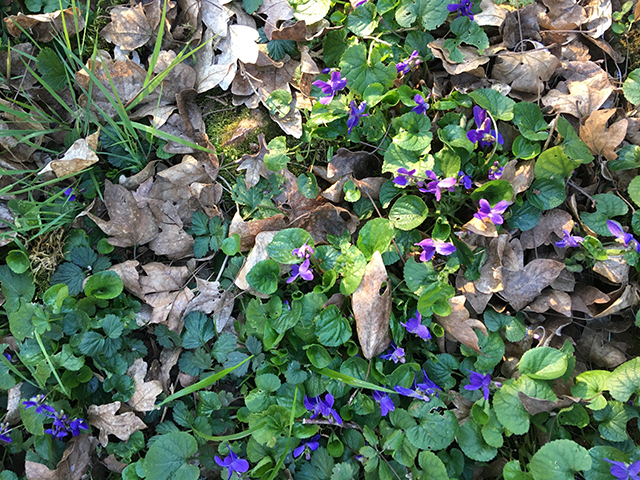
The sheep around me
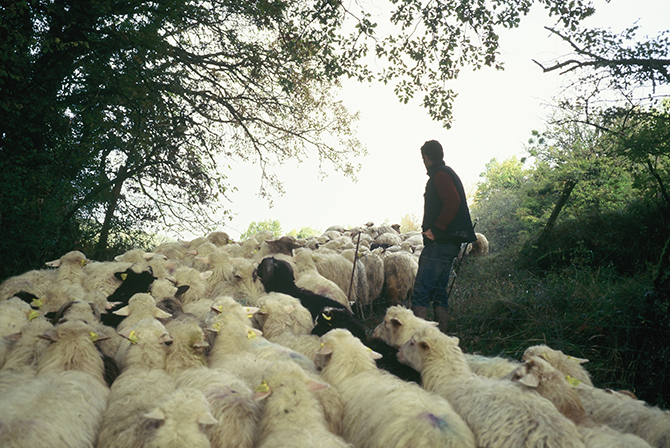
I live surrounded by causses, landscapes that have been shaped by sheep farming over centuries. Sheepfold, shepherds shelters and low walls separating plots, all made of dry stone, are reminding us of this past. Causses, which are limestone plateaus , are situated several hundreds meters above sea level but are not mountains, not even hills, they are flat. On these plateaus, because of the specific composition of the ground, not much can grow. Farmers have been grazing sheep here since the beginning of time. The sheep are raised for their milk which is made into cheese. To produce milk, sheep have to have lambs every year, whom are traditionally killed and eaten for Easter, following Christian, Jewish and Muslim traditions. The wool, sheared every year, is also used for bedding (mattresses, pillows, blankets) and clothes. There is one kind of sheep that is specific to the region where I live, that is commonly called ‘sheep with glasses’ because they are black around their eyes. It looks like they have black glasses on.
Nowadays sheep farming is less common here, unlike in the Basque Country where it remains an important activity.
One of my friends is a shepherd. His name is Antoine and I photographed him for my slide show, Ici-bas. He didn’t come from a shepherd family but he wanted to lead a different life. The shepherd is still a synonym of freedom and solitude, maybe similar to a traveling monk in Asian cultures. It’s hard work but you get to live in nature, with the cycles of seasons. Antoine’s sheep, of Sarda breed, are particularly beautiful. He treats them with much respect and uses natural remedies whenever they get sick. In the Summer he moves his flock to another location so that the sheep have access to more grass. This move is called transhumance and is practiced in Europe since prehistoric times.
I recently visited the mountains of Basque country close to the Spanish border. We could see many sheep in their summer grazing, free on the land, no fences. There was different types of sheep. Among them black face manech, typical of the basque country, whose wool is particularly hard and itchy. I have a sweater made of that wool by Mary, the old woman who was spinning and knitting wool in my village. When she turned 90 years old, two years ago, she stopped her work. I am so happy I could buy several of her pieces made with raw wool and which have a very unique feel. Mary was using whatever wool was given to her by shepherds. The manech wool pieces, even though not very comfortable, are the most beautiful to look at.
I find it magic when I see sheep. These white fluffy silhouettes punctuating the land. Sometimes they look at me and when our eyes meet I get mixed feelings. I am reminded I also am a mammal.
September, 2021
Elein Fleiss
Photography: Elein Fleiss
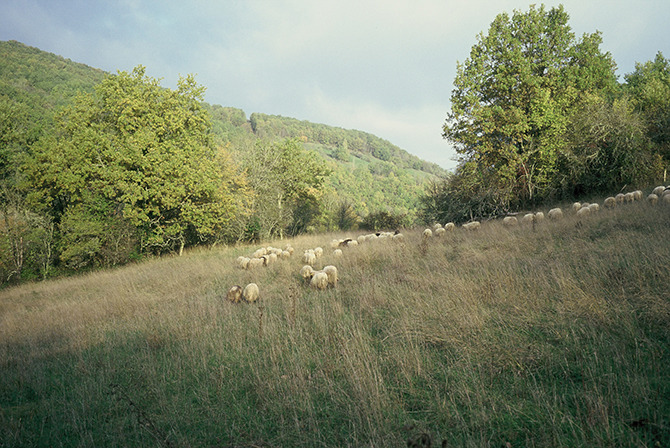
Saiki
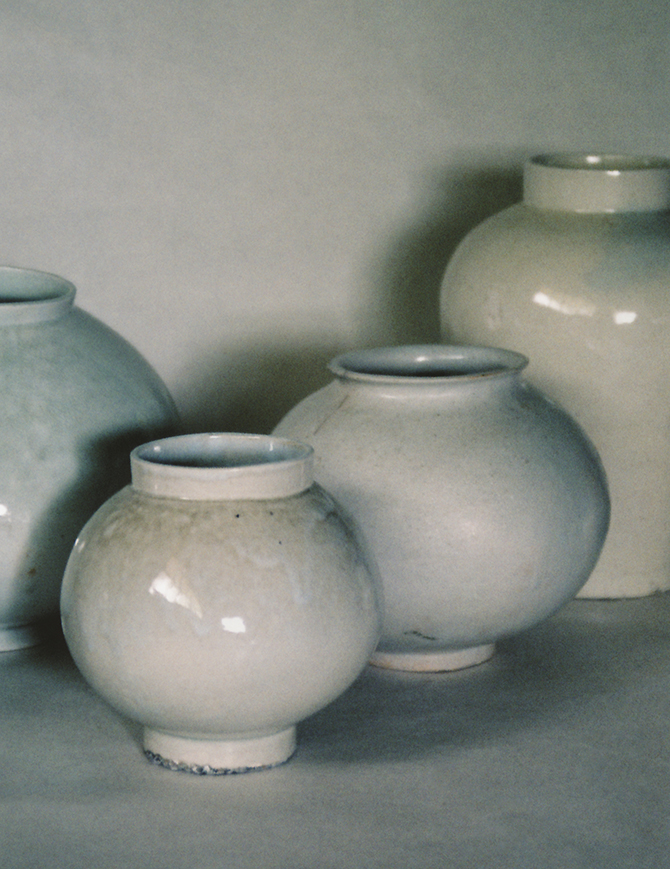
At the weekly “Asuka Bio-marche” in Asuka Village, Nara, you can find naturally-grown vegetables and rice, post-harvest treatment-free eggs, makomodake and mushrooms harvested in autumn, vegan burgers and smoothies, Indian home-cooking and “Indian pho” with gluten-free rice noodles, home-roasted organic coffee, and so much else. The stands of farmers and café owners are always crowded. I love to go to organic markets and always look for one when I travel. I feel enriched and energized when I see the fruits and vegetables of natural and organic cultivation, the daily careful work of the people who produce them, and the fruits of the unity of people and nature. Shigeo Tanaka and his partner Sachiko, who live and make pottery in Asuka Village, once took me to the Asuka Bio-marche. The lunch we had there, made with naturally grown vegetables and spices, was very tasty and delightful under a blue sky.
Next to Shigeo Tanaka’s kiln in the mountains, there is a naturally cultivated field which he uses to prepare various vegetable dishes. His dishes and sweets, which have evolved in a unique way by combining the practices of natural food therapy, yin-yang layering, fermentation, and raw food, are wonderfully delicious and go beyond the boundaries of home cooking. After the meal, Shigeo-san makes us coffee from his own roast. There is a well in the kitchen from which he draws the water to boil. The thoughtful and detailed dishes and drinks are served on dishes made by Shigeo, who pursues invisible and spiritual movements.
I wondered at how much time and effort goes into these naturally-grown vegetables, how much power the carefully nurtured life has, and how much is condensed in the meals made from them. When we eat these precious things, we want to consume them with all our hearts and enjoy them. Many of the vessels that Shigeo makes are in the form of ritual vessels that are dedicated to the gods. I use these vessels daily at Ryugu. It is a pleasurable thing for me to serve food on vessels that express a kind of spiritual vibration. Created in the mountains with clay, fire and him, these are things that express the vitality of the spirit.
Aug 15, 2021
AAWAA
Wild grasses
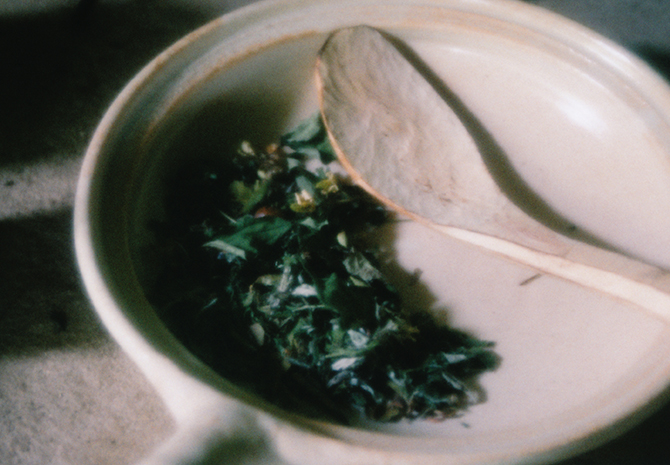
Medicinal plants are wild grasses
Wild grasses are the herbs of medicine
Medicine is found in the wild
Wild grasses are connected to the ancient earth.
They have coexisted with the earth since long before mankind.
Grasses are full of life force
The minerals of the earth
The energy of the field
By taking in the power of the plants and grasses into your body
the ancient earth and the cells of living things resonate with each other
your body and mind will be in harmony
Free and easy
To use the five senses
To loosen and open the mind and body
To be bathed in the light of the sun
To breathe deeply
To take in the scent of the grass, the drops of the grass
To let the blood flow through the body
To take in the memory of the ancient earth
We call it wildflower tea.
Each grass has its own name and role
that supports the life of all living things
It provides food, clothing, housing, and spirit for all living things.
In the past, people and grasses were very close.
Once again
As in the past
as something close
Instead of keeping the grass away from the soil
Now is the time to make the wild grass our friend
We are continuing our wildflower activities with the hope that they will be useful in our daily lives
Our axis is the natural world.
To put down roots in the earth
To have a connection with the soil and the grass
To enrich our hearts and lives through grass
When we face the wild grasses and weeds
We learn that everything we need is provided for us
We don’t have to depend on others, and we don’t have to look only to the outside
Now is the time to rethink our relationship with our surroundings
We remember when we were good friends with the earth and grass
If we do that
A bond between people and plants
may be born again
With the rapid changes in the environment, the culture of wildflowers seemed to have died out
But thanks to our ancestors, we are now able to learn about it
We can again become familiar with
Forgotten,
Cut off
Neglected plants and grasses
Wild grass
Rethinking Plants
Returning to Nature
May 27, 2021
yasousora


 Facebook
Facebook Twitter
Twitter